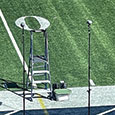Many beginning conducting students begin by learning the best posture, including proper foot placement, erect upper body carriage, and the right elbow height. Then a baton is introduced. Corrections are made to the baton placement, and the student is set in the ideal conducting position. Next, a pattern (34 or 44) is taught, and students are on their way. However, this pedagogy – starting with a simple pattern, baton in hand, in a prescribed conducting stance – can be inhibiting in a number of ways.
Conducting requires communicating concrete instruction directly to the ensemble. By introducing the baton, patterns, and a stance immediately, most young conductors are inhibited and cannot fully express the music and themselves. Players are accustomed to using their instrument to express themselves; this creates a buffer between the player and the audience. When instrumentalists begin conducting, they learn to communicate through a new medium. Conducting teachers should promote musical movement first, rather than strict rules and procedure.
Starting with strict rules and procedures advances the idea that conducting is about technical proficiency and patterns first and foremost, when it is truly about communicating musical ideas and intent to the players. This will usually be done through traditional patterns, but these are means to an end, not an end themselves. Colleagues have argued to me that because beginning players are taught with the same strict rules: good posture, proper horn carriage, and correct mouthpiece/mallet/bow placement, beginning conductors should be taught the same way. There is an important distinction between these two situations. In the case of beginning players, they likely have little or no playing experience, and many have limited musical experience. They are learning how to become musicians, which requires these kinds of disciplined rules and procedures. Beginning conductors should be accomplished musicians who are learning to express their musicianship in new ways. Clarity and discipline are important in conducting but must be at the service of musical expression.
Additionally, the baton is a focal point for an ensemble and an effective tool for conducting, but it is only a tool. Conducting is done with the hands, body, and face, and there should be freedom for young conductors when learning expressive movement. A baton should be added only when the conductor is comfortable with this kind of movement. Employing a baton too early can make students self-conscious about technique and shifts the focus away from being outwardly expressive.
These problems can be remedied by introducing body awareness and expressive movement before posture, baton, and patterns. Students benefit bing able to express themselves openly and freely, especially considering that beginning conducting students are coming in with little or no experience in front of ensembles. It also dissuades students from the belief that patterns are conducting. There are exercises to promote physical freedom and expressive movement, and while they are essential for inexperienced conductors, even veterans may find them helpful.
Body Awareness
Students are often unaware of how much tension they carry in their body or how poor their posture tends to be. There are a few exercises that can promote better awareness as fledgling conductors prepare for what can be a rigorous physical activity.
The Penguin
If done properly, this exercise will create significant tension in students’ bodies. It can also be quite tiring, so limit the number of times it is done consecutively. To start, students should spread out across the room; each student will need a full arm span of space around them. Instruct them to do the following:
1. Stand up straight, feet together.
2. Raise the shoulders toward the ears.
3. Straighten both arms and place them at the sides with the top of the wrists anchored to the legs.
4. Flap the hands as fast as possible.
5. After 30 seconds, stop and release the tension from the body.
Students often begin to moan or giggle from the tension they are experiencing. Some will begin to sweat, others will hold their breath. To illustrate the differences between tension and relaxation, immediately follow this exercise with the next.
Swinging Arms
This is a simple but challenging exercise to see if students can relax their bodies. It should be done in tandem with The Penguin because the two together demonstrate the differences between bodily tension and relaxation.
1. Make sure to stand at least a full arm span away from other students
2. Relax the shoulders and stand comfortably with feet generally shoulder width apart.
3. Slowly and gently begin to twist the torso from side to side.
4. Gradually increase the energy and momentum.
5. After approximately 20 seconds, decrease the energy.
6. Come to a stop at 30 seconds.
If done properly, the arms will swing freely and bounce off the side of the body on each side. As the energy increases, the arms will swing higher. As it decreases, the arms will descend. Students tend to keep their arms rigid and attempt to artificially control the movement. Check for that issue and instruct students to allow their arms to flop at their sides. Repeat the exercise until the students can swing their arms free from tension. This will show them what it feels like to really relax their bodies. This relaxation will lead to better endur-ance and lower likelihood of soreness and injury from conducting.
Body Movement
A good musician can perform and explain how to phrase a passage of music, but for a conductor it is necessary to express these ideas in physical form. The message and intent must be not only be clear but also mean the same thing to all ensemble members. Expressing the intent of the music requires comfort with moving the body, specifically moving rhythmically through space in front of others. The former encourages freedom of expression, and the latter acclimates them to moving in front of an audience. The following exercise encourages expressive freedom with the body and can be repeated over several class periods with an assortment of different music and styles.
Moving Freely
This exercise is designed to get students moving to music through a large space. To begin, have them students scatter throughout the room, spread out so each student has enough space to move freely. Have the class listen to a musical excerpt once without moving about or mimicking conducting patterns. Play the excerpt again, this time having the class move in place to it. The motion should reflect the music but avoid traditional conducting patterns. Following this, play the excerpt a third time, having the students now move about the room to it.
Each time, allow the excerpt to play all the way to the end, no matter the students’ reactions. Typically students will be tentative at first. Some will joke. Others will move very little and hope no one is looking at them. A few students will perform for the others, moving histrionically around the room to get attention. These reactions are often defense mechanisms against the embarrassment and nervousness they feel doing this exercise.
How they look does not matter at this point. It is important that everyone is moving with some level of intensity. At the end of the exercise, ask students what the music was expressing and how they were translating that to motion. I do not do this beforehand because the students tend to gravitate to the same idea and imitate each other. Have someone with a particularly strong answer – or someone who looked confident in the exercise – demonstrate for the class. Repeat the exercise using different styles of music. This can include different genres, from classical to jazz to rock, or any other music that has a strong style and personality.
Eventually, this exercise can be adapted to reduce the amount of movement. Although students begin by moving through a large space, eventually the available space should be reduced to the dimensions of a podium. Then begin to eliminate leg movement, restricting the motions to the upper body, thus preparing the students for more conventional conducting styles.
Facial Expression
I have seen a number of conducting teachers tell students to “show the music in your face,” a phrase that may not have much meaning to a novice conductor. Using meaningful and expressive facial expressions can be a foreign concept, especially to wind players who have had an instrument in their face during most of their musical training. As for string players, keyboard players, and percussionists, the facial expressions they employ in performance may or may not appropriately or effectively convey the musical idea the way it would need to be communicated when conducting an ensemble. Students should get to the point at which they feel uninhibited by physical or psychological barriers, and in the case of facial expression, it is often more psychological than physical. There are two exercises for helping students to better express themselves using their faces.
The Silly Circle
Students stand in a circle in the middle of the room. One student is selected to begin by making a facial expression of his choosing at the person to his left. That student imitates the expression, turns and makes a different expression to the person on the left. This continues until the circle arrives back to the person who started. Instruct students to make emphatic and exaggerated expressions so it is obvious to the person to whom they are turning as well as everyone else in the class. Students should also use their entire face when making the expression.
A few things will likely occur during this exercise the first few times it is done. Some students will make little or no discernible expression, while others will copy expressions they have already seen. Additionally, some students will giggle. They laugh impulsively at the exercise – and not necessarily the expressions – as a way to diffuse the situation. Those who do not make expressions are often concerned about looking silly in front of the other students. This concern can also cause the circle to move too slowly as the students overthink their expressions. Assuming some or all of these things will occur, inform the students to move quickly by concentrating on the exercise, making split-second decisions on the facial expression, and just doing it. In conducting it is necessary to be reactive and proactive at the same time, which is what the silly circle encourages.
Repeat the exercise several times. Even a slow circle only takes 30 seconds in most conducting classes, and one done correctly the exercise is completed in seconds. Over time students will learn to make facial expressions quickly and emphatically, as is demanded when conducting.
Conclusion
These are only a few of the exercises that can be done to promote physical expression and creativity. Once the students become more comfortable with free, expressive, and intense physical motion, only then is it time to add beat patterns.






